Review of the Gigabyte Aorus 7000s PCIe Gen 4 NVMe SSD
Remember when PCIe Gen 4 m.2 NVMes were a new thing? Doesn’t seem that long ago, does it? In fact, the first generation of M.2 SSDs to take advantage of the 8GB/s possible via PCIe 4×4 is barely a year old and in the first half of 2021, we saw the 2nd generation quickly obliterate our understanding of what an SSD can do, with the Aorus 7000s from Gigabyte is a great example of this. Although by no means the first the take a stab at the 7GB/s Seq Read SSD market (with the WD Black SN850, Samsung 980 Pro and Sabrent Rocket 4 Plus getting their products to market before everyone else), it does arrive with hardware architecture, top-end performance and a price point that gives those other brands SSDs something to stop and think about. Plus it is now on the PS5 SSD compatibility list, so many keen gamers will be considering it for their next big storage upgrade. The Aorus 7000s is an SSD by motherboard manufacturer Gigabyte who know a thing or two about PC architecture, but how much of this lends well to NAND based storage? They are utilizing the popular Phison E18 controller, 96 layer 3D TLC Micron NAND and DDR4 memory on their tiny 2280 SSDs, so things look good on the spec sheet, but how good is the Aorus 7000 SSD in reality? Let’s have a close look at this SSD and decide whether the 7000S deserves your data?
Gigabyte Aorus 7000s SSD Review – Quick Conclusion
You cannot fault the Aorus 7000s NVMe SSD for its performance in 2021/2022, as it does not over-promise on what it can do. We ran all our usual tests and it hit the highs and lows of Throughput and comparative IOPS to others, just as the brand volunteered. The Gigabyte Aorus is a mature and grown-up SSD and not one that is trying to challenge bigger drives like the Seagate Firecuda 530. Had it been released a few months earlier, it would have made a significantly bigger splash on the professional gaming and video editing market, but now runs the sight risk of getting lost in the paddock of Phison E18 SSDs that are arriving on the market around this. The Aorus’ price point and availability certainly make it appealing, but the shaky SSD market making a slow recovery from Pandemic changes, Chia stock issues and semiconductor shortages means this SSD might not be as desirable as it should be when it is not as abundant at the manufacturing level as the likes of Seagate, Samsung and WD’s offerings being so copious. This IS a good SSD and although the IOPs are a touch lower than I would like, its durability, performance at both 1TB and 2TB and inclusive slimline prosumer heatsink make it a very good drive indeed!
Gigabyte Aorus 7000s SSD Review – Packaging
The Aorus 7000S arrives in a petite 2 stage card box retail box. The shiny holographic logos and text immediately throw me back to my childhood and I would be lying if I said I didn’t spend a few extra seconds playing with it in the light- sue me! It is quite a tight fit and there is not a vast amount inside.
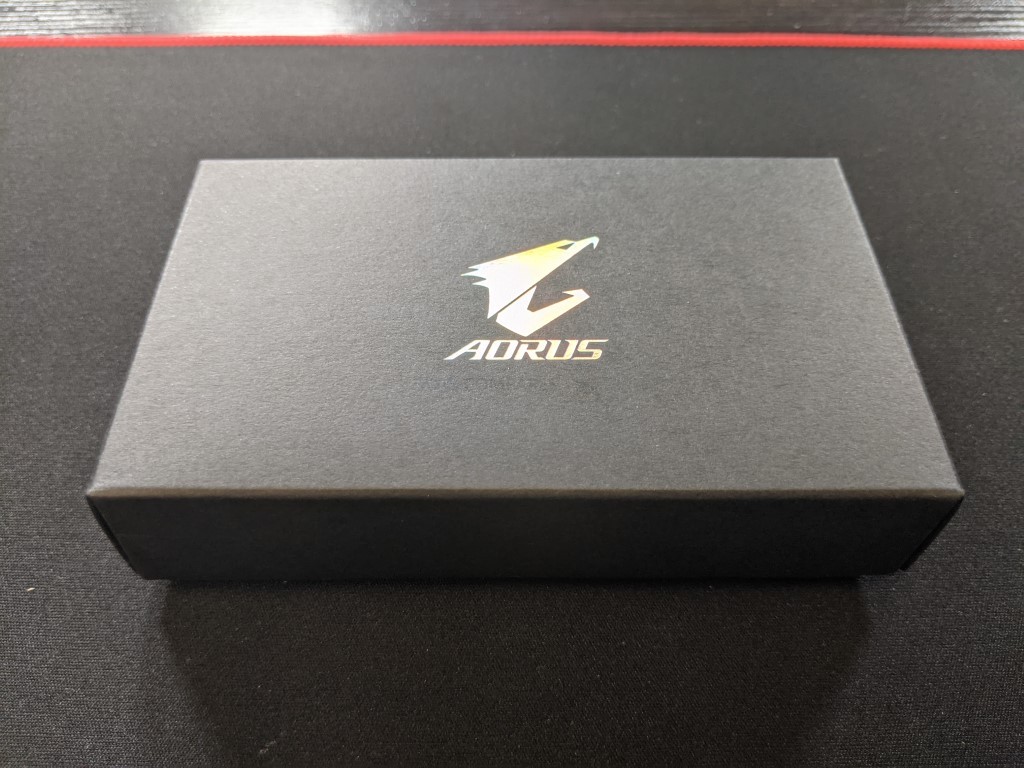
The Aorus arrives with an inclusive first-party heatsink which arrives pre-applied and sealed by 4 screws. I was immediately impressed by this heatsink and it toes a fine line between effectiveness and sharp design, whilst still arriving surprisingly compact. Indeed in recent weeks, I have been talking about heatsinks more and more (like the use of M.2 NVMe SSD has become increasingly mainstream and people do not know how VITAL these things are).
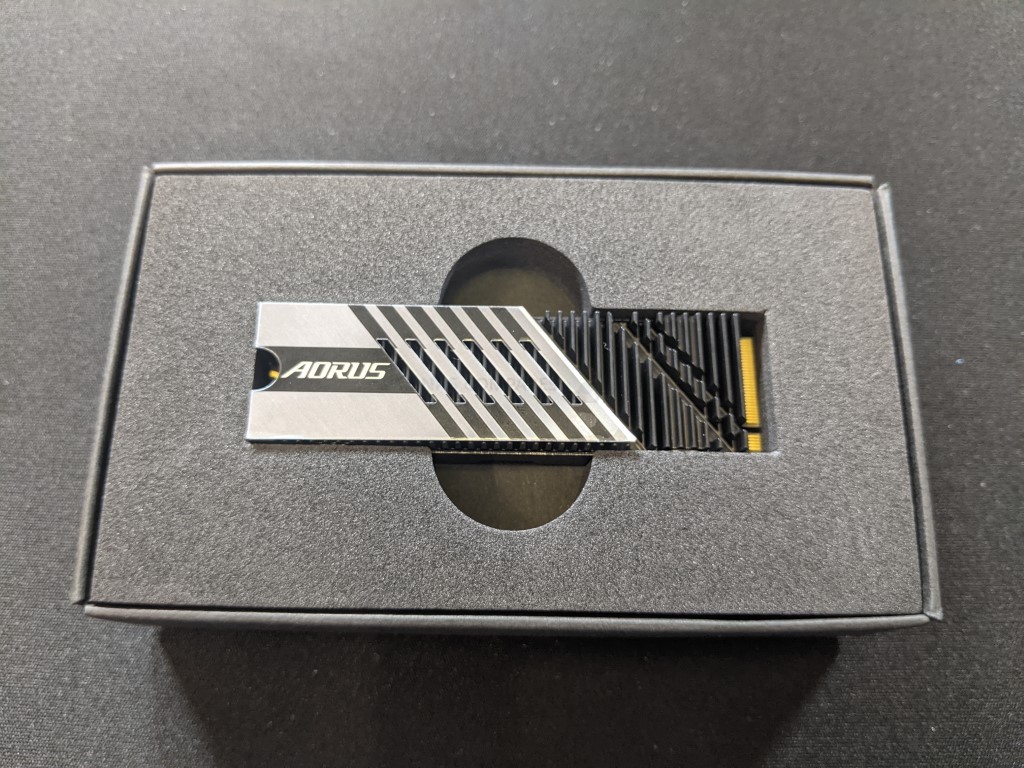
Let’s be clear, M.2 NVMe SSD heatsinks are NOT expensive, ranging from $8 for the most basic to higher-end engineering examples at $20-30. The Aorus SSD heatsink is compatible with many $15 examples and does certainly give you a feeling of quality. Indeed, the fact some SSDs arrive with optional heatsinks, given the affordable price point, seems crazy to me. Yes, there is the argument that users might already own their own prosumer heatsink or using a compact/custom setup that has its own heat dissipation methods, but the larger portion of the audience would have to faff about getting another one. So yeah, kudos to Gigabyte (again, motherboard manufacturers – important there!) for including this and making an effort on it!
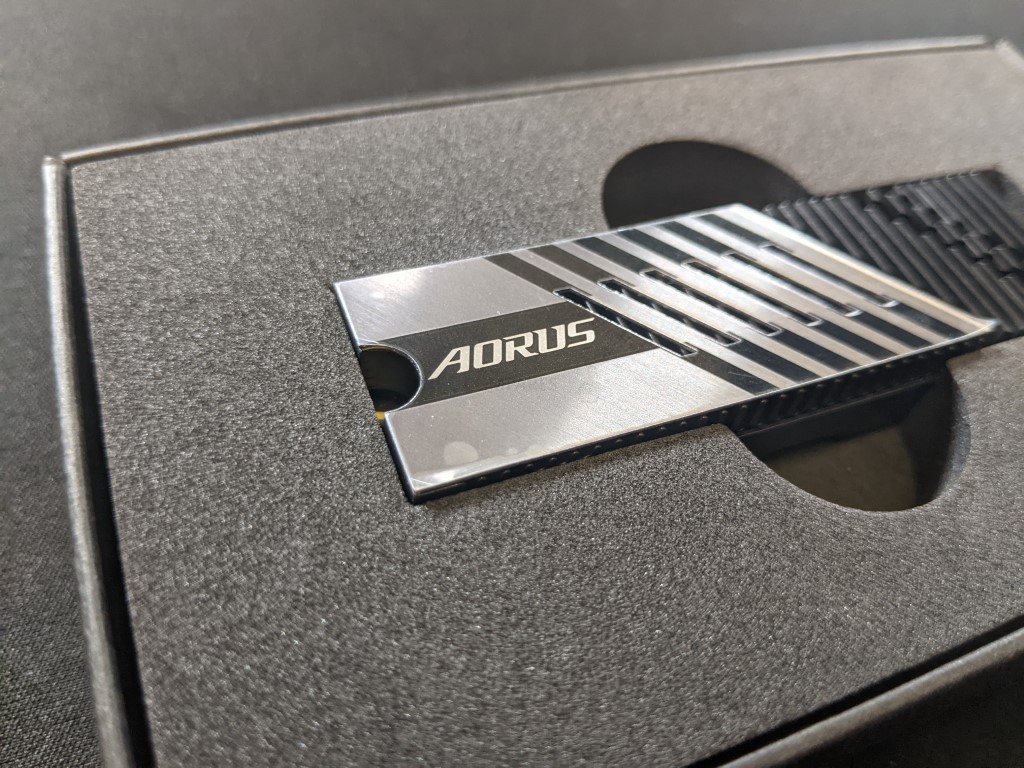
The Aorus 7000s is a 2280 length SSD and it is completely contained in the 2 part surround heatsink.
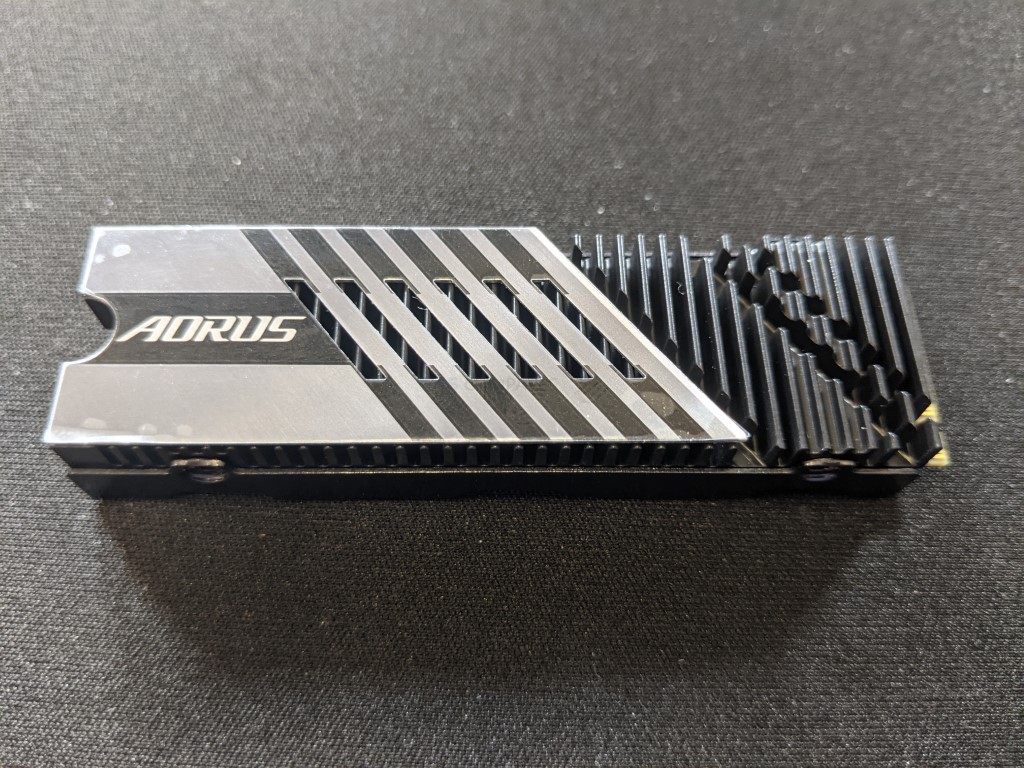
There is a good level of ventilation space on both the top and sides of the heatsink, whilst still ensuring not to rise the M.2 key connector (something of a problem with larger heatsinks and double-sided SSDs).

Indeed, the M.2 connector is the ONLY part not completely covered in heat dissipation panels. The Aorus 7000s 1TB is a single-sided NVMe SSD, but both sides of the drive are buffed with thermal panelling.
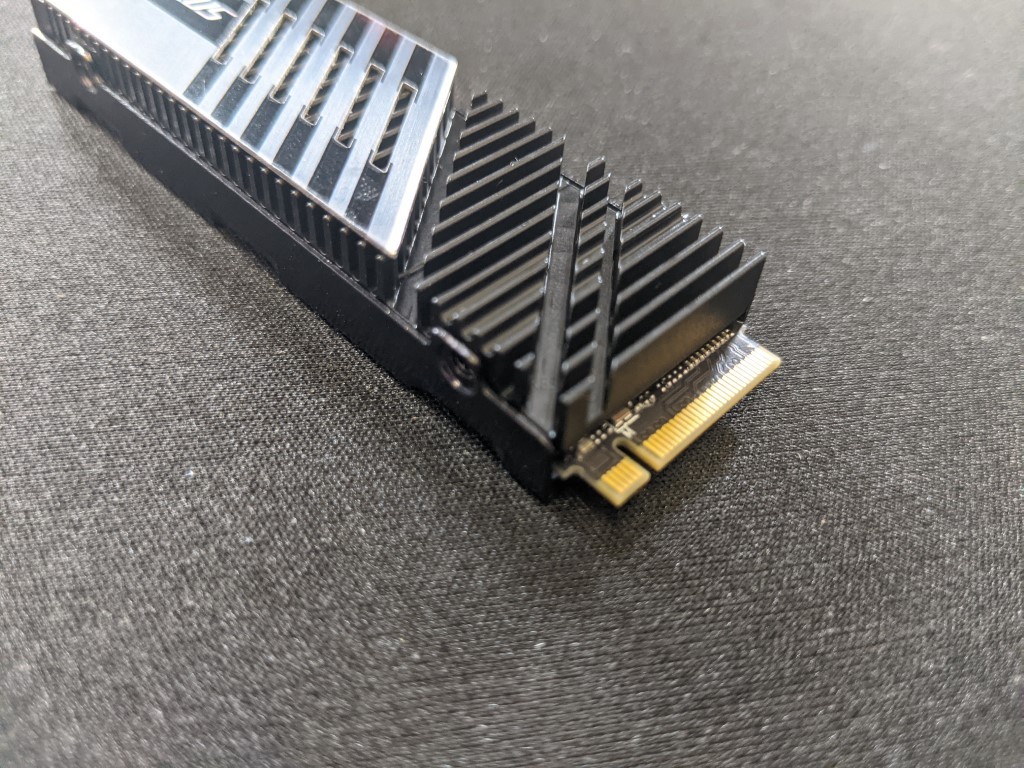
Removing the four screws on the sides of the Aorus 7000s heatsink was quick work, however, the surrounding metal heatsink cage is tightly connected together and removing the SSD from both heatsink panels and thermal pads was actually a lot harder than you might think.
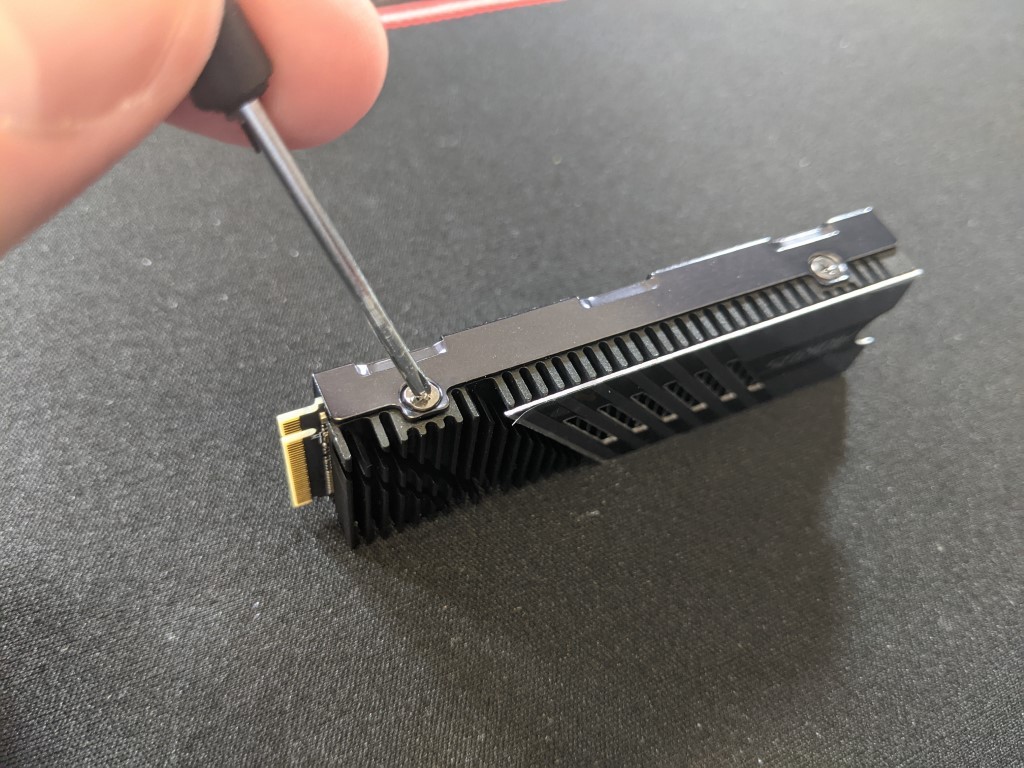
indeed, the Aorus 7000s SSD is so tightly caged in this petite heatsink that the indentation of the chips on the thermal panels is remarkably defined! There is little to no overspill and I can definitely say this is a very slick application (which I have now spoiled) and leaves me feeling confident in how well it will protect the drive in use from temp rises.
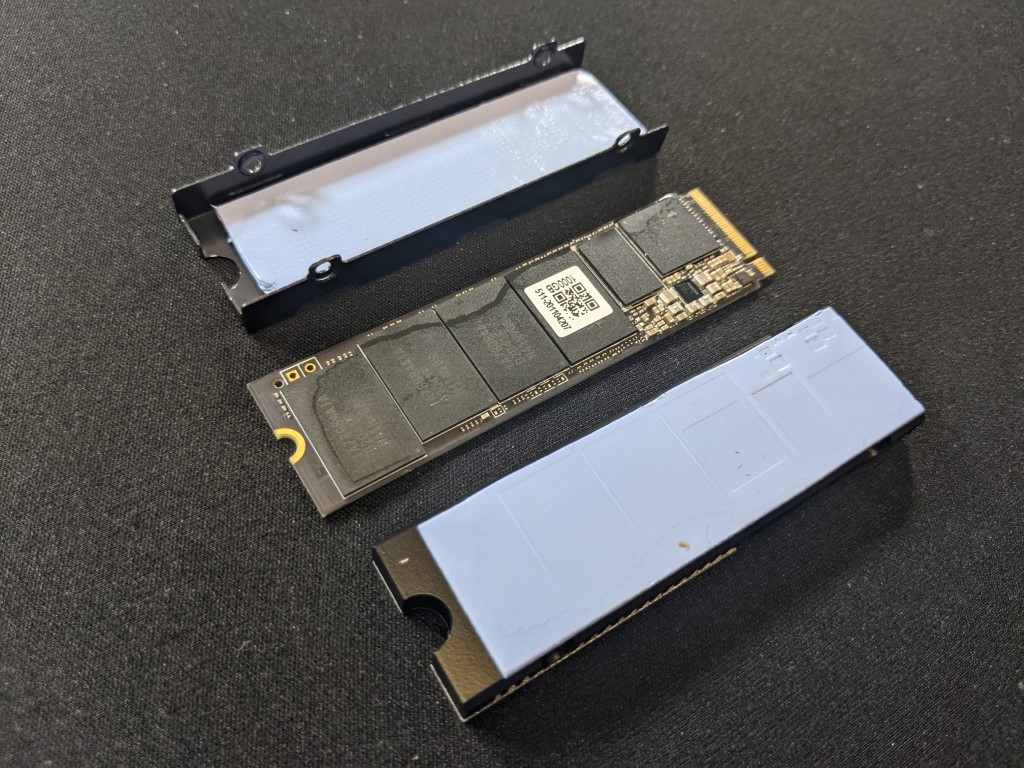
Interestingly, if you line the heatsink and Aorus 7000s up, you can see that the additional flow lines of the top line up directly over the Phison E18 and 1GB DDR4 memory, which is exactly what I like to see for focused airflow/dissipation. This is a nice little design mark and something that many could easily blink and miss.
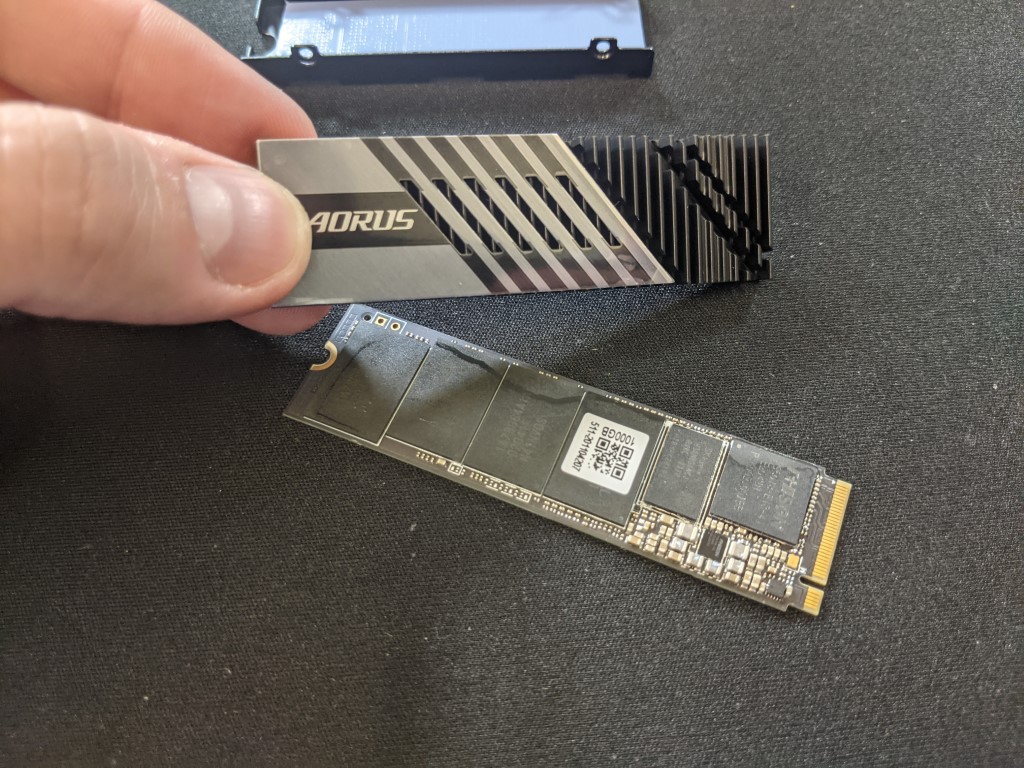
Removing the heatsink entirely, we can take a much closer look at the Gigabyte Aorus 7000s chips on the 2280 PCB. Again this SSD is single-sided, so the distribution of the NAND, Memory and controller are all lined up neatly.
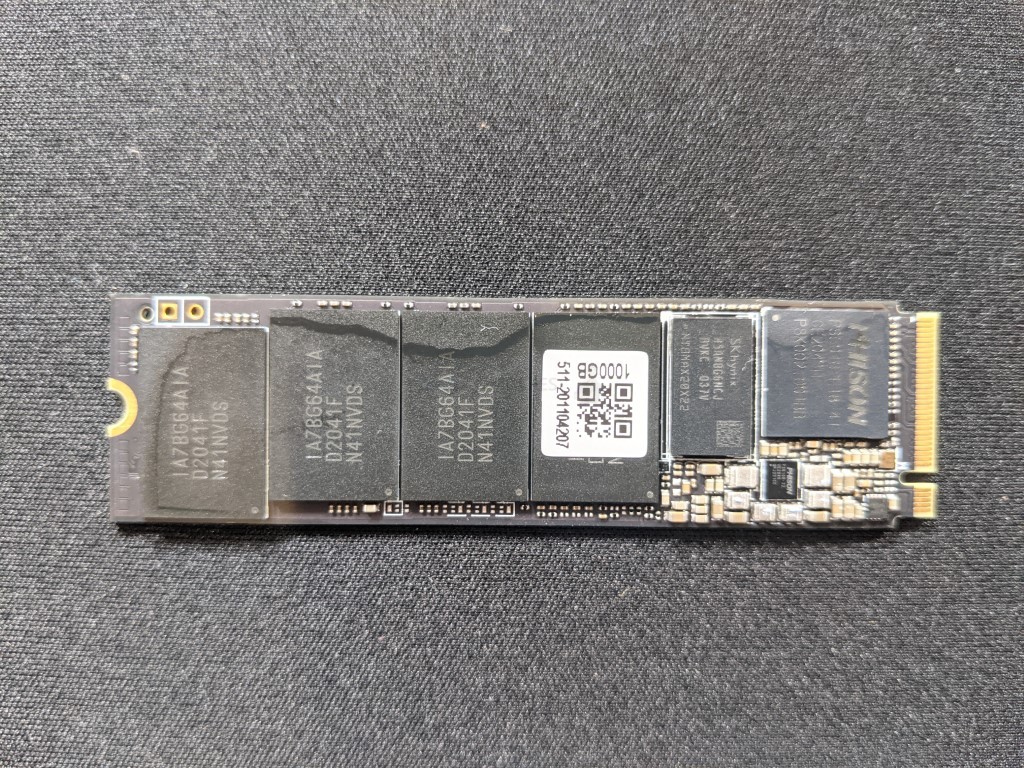
The other side is the bare board. Larger capacities will of course take advantage of this additional space.
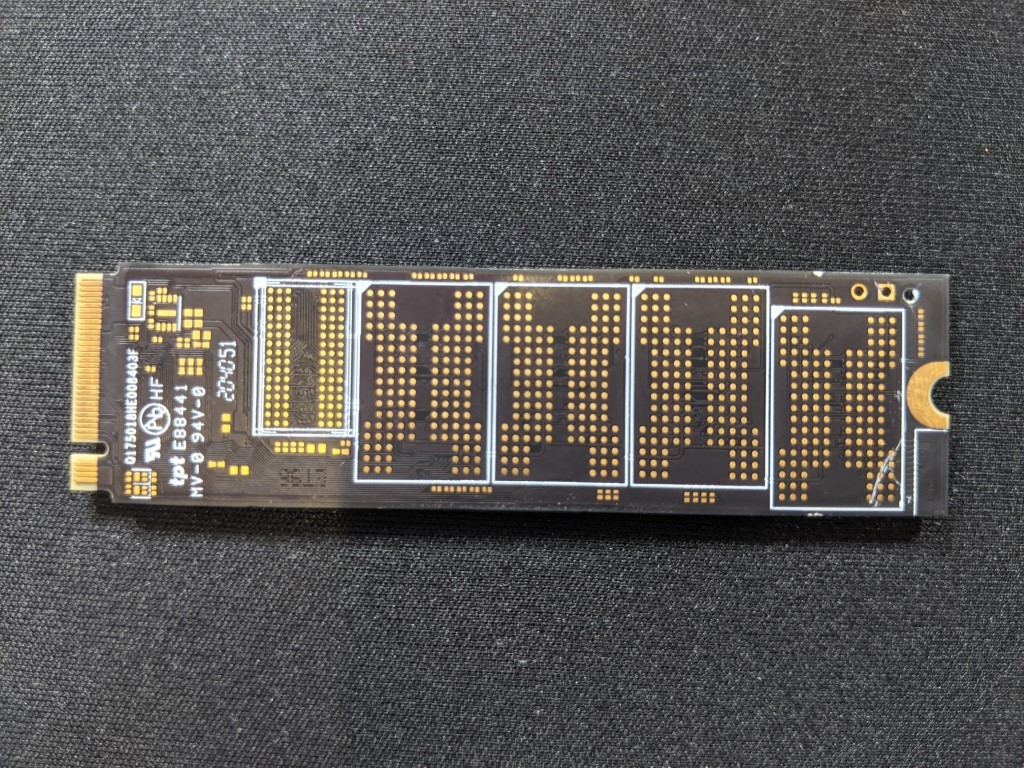
So that is the physical design of the Aorus 7000s SSD. But what about the hardware components themselves? Does the Gigabyte Aorus 7000S cut the mustard in terms of current generation hardware and protocols? Let’s find out.
Gigabyte Aorus 7000s SSD Review – Hardware Specifications
As you might expect from an M.2 NVMe SSD that boldly promises performance of 7,000MB/s sequential read (ie BIG data), the hardware specifications and architecture of the Aorus 7000s are quite modern. Indeed, for all the big talk of the Seagate Firecuda 530 hardware (still currently the ‘score to beat’ PCIE Gen4 m.2 NVMe right now) being top tier, the Gigabyte Aorus 7000s is pretty darn similar on the spec sheet! Below is how it looks:
| Brand/Series | AORUS Gen4 7000s |
| PCIe Generation | PCIe Gen 4 |
| NVMe Rev | NVMe 1.4 |
| NAND | B27 3D NAND 96L |
| Max Capacity | 2TB |
| Controller | Phison E18-PS5018 |
| Warranty | 5yr |
I know a lot of the above will seem needlessly technical, so below we can bring the most important considerations into sharper focus.

Hardware Focus of the Gigabyte Aorus 7000S SSD Series
The first big, BIG thing to remember here is the controller, that Phison E18. An SSD is much like a microcosm version of a whole computer. The Controller is equivalent to the CPU, and Phison are one of the bigger 3rd party SSD controller manufacturers in the world! I say 3rd party, because some long-running storage brands like Samsung and WD have most of their development and hardware engineering ‘in-house’ and use their own branded controllers. Whereas some brands source some/all components for their SSDs from 3rd parties – which is not necessarily a bad thing for both them and the industry (there are pros and cons on either side). Phison has been at the cutting edge of this subject for years now and the E18 was first revealed last year in 2020, but due to the pandemic making storage trends unpredictable and semi-conductor shortages, most SSDs that utilized the Phison E18 eventually arrived in 2021. This controller is one of the biggest reasons that the Gigabyte Aorus 7000s can actually backup it’s promises about the 7,000MB/s+ Sequential Read (sequential data = big chunks of data). However, that is not the only reason.
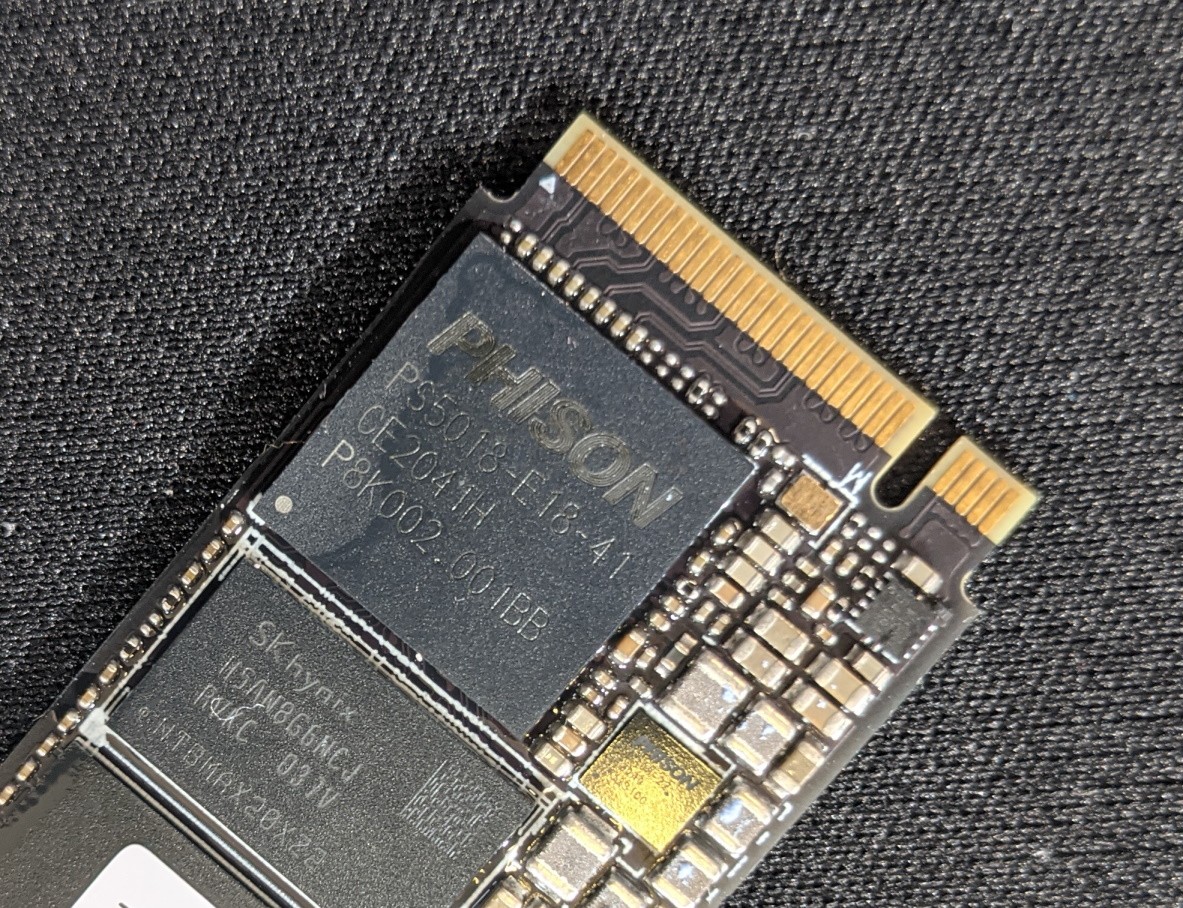
The NAND on the Gigabyte Aorus 7000s is where the data lives! SSDs (as you no doubt know) do not use moving parts as found in traditional hard drives and instead uses cells that are charged and data is read/written to them in this process. The quality of the NAND and the layers used will make a big difference to the durability and performance of an SSD and although the Gigabyte Aorus 7000s does not provide the best SSD in the industry at this tier right now (that, once again, goes to the Seagate Firecuda 530 at 176 layer 3D TLC NAND), it is bigger than most, arriving at 96 Layers of 3D TLC NAND. Although the majority of modern PCIe M.2 SSD use 3D TLC NAND (avoid QLC NAND like the PLAGUE btw!), most are still at 64 layers or so, so this is a big jump up for the Aorus 7000S SSD.
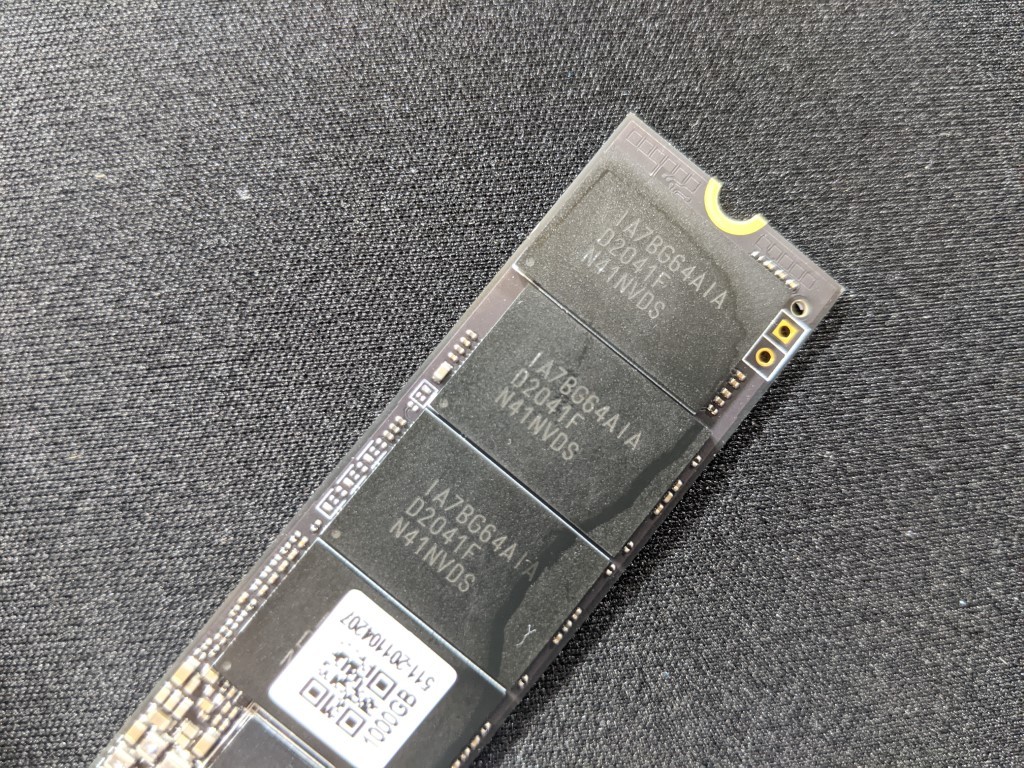
Much like the Controller on the Aorus 7000s being the ‘CPU’, it also has an area of memory. The Gigabyte Aorus SSD uses 1GB DDR4 memory on board and this in conjunction with the SSD provides a massive body of data handling resources for getting your data moving through the SSD and out of the m.2 NVMe PCIe 4 interface. The amount of memory scales in conjunction with the 1TB or 2TB SSD you use, with 2GB of DDR4 at the on the 2TB tier.

As mentioned, both available capacities of the Gigabyte Aorus 7000s arrive at 2280 in length. This is quite normal for the 1TB and 2TB versions, but the fact they arrive on single-sided SSD boards is very impressive. Physical storage NAND is distributed evenly in order to space out the storage and allow even cooling, NAND wear and performance. Do remember that this means you won’t need to be so attentive in provisioning for heat dissipation on both sides of the NVMe M.2 SSD, as the 7000S includes a decent heatsink anyway that uses a metal surrounding heatsink and base level thermal heat pads, this is all largely taken care of.
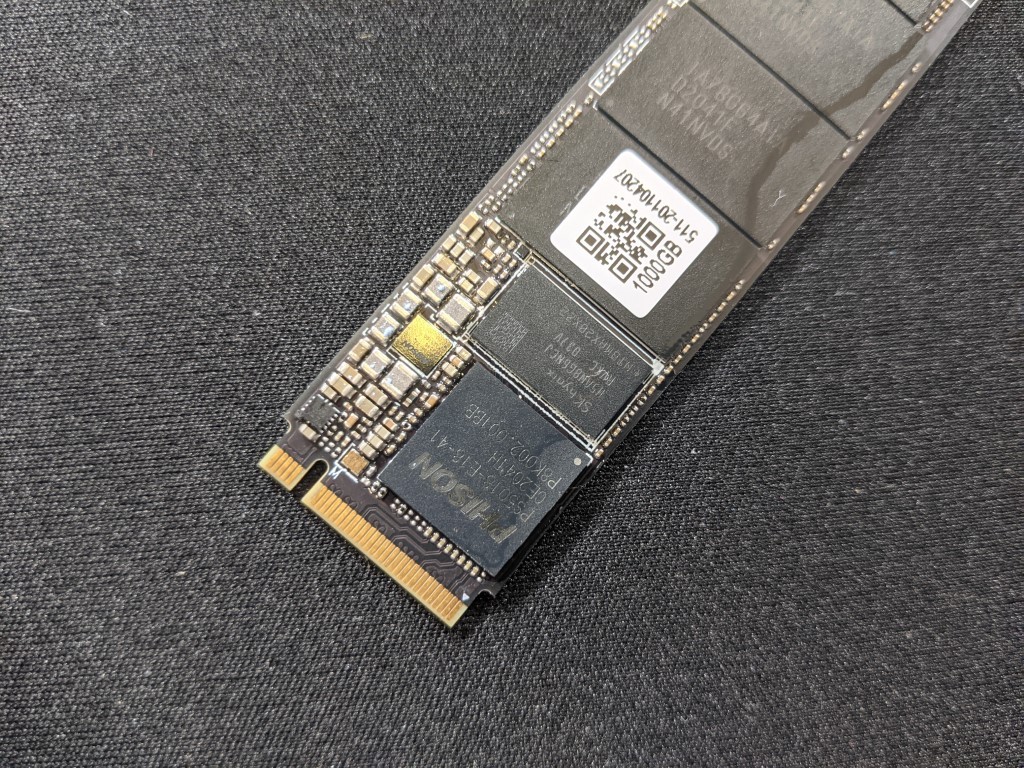
Finally, there is the M.2 NVMe connection. Not all m.2 SSDs are created equal and although M.2 SATA and M.2 NVMe look similar, they provide massively different performance and connectivity. However, the Gigabyte Aorus 7000s takes it one step further, by using a newer generation of PCIe Connectivity. In short, M.2 NVMe SSDs are connected to the host PC/Console system via PCIe protocol (think of those slots that you almost always use for your graphics cards, but a much, MUCH smaller connector). These allow much larger bandwidth (ie maximum speed) for the connected storage media, Much like regular PCIe slots, they have different versions (i.E PCIe Gen 1, 2, 3, 4, etc) and also a multiplying factor (x1, x2, x4, etc). Up until around 18 months ago, the best M.2 NVMes were M.2 PCIe Gen 3×4 (so a maximum 4,000MB/s possible). However, never generation SSD like the Gigabyte Aorus 7000s use PCIe Gen 4×4 (a potential 8,000MB/s possible) and it is only now that SSD controllers and NAND production has reached a point where it can catch up and fully saturate (i.e fill) this connection.
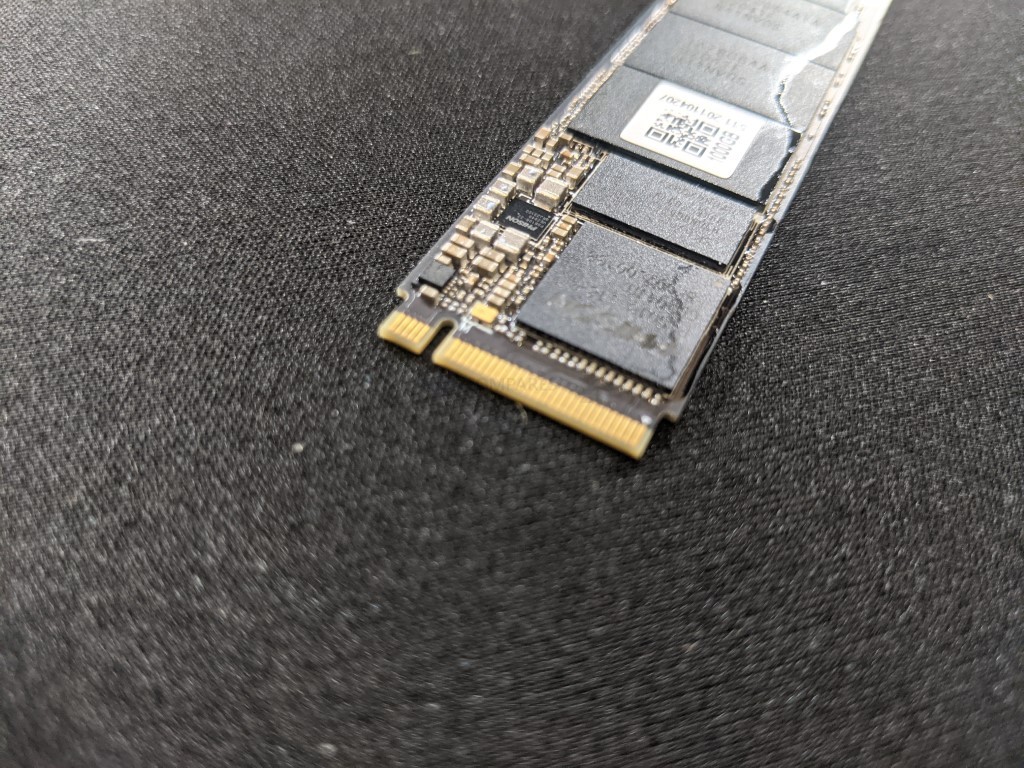
Overall, you really cannot fault the hardware inside/onboard the Gigabyte Aorus 7000s, as it is still (2-3 months after release) higher performing in sequential Read and Write than many other M.2 NVMe PCIe 4 SSDs released in that time. Before we go into the full testing, however, it is worth taking a moment to look closely at the reported performance benchmarks of the Gigabyte Aorus 7000s, as although the performance seems stellar, there are areas such as IOPS and endurance when compared with its main rivals that are worth taking into consideration.
Gigabyte Aorus 7000s SSD Review – Official Stats First
Before we conduct our own testing on this SSD, Let’s take a closer look at the reported specifications and benchmarks first. The Gigabyte Aorus 7000s SSD arrives in two capacities at 1TB and 2TB. The Prices currently are a little inconsistent (with each higher capacity tier actually having a higher price per GB – quite unusual) likely due to the hardware shortages, the Pandemic, Chia has affected SSD availability in the last 12 months and most recently the announcement that PS5 supports this SSD and it has increased the current price of both models around 20-30%!. Below is a breakdown of how each Aorus 7000s SSD compares:
| Brand/Series
|
AORUS Gen4 7000s
|
AORUS Gen4 7000s
|
| PRICE | GP-AG70S1TB | GP-AG70S2TB |
| Price in $ and $ | $199 / £189 | $359 / £399 |
| Throughput | GP-AG70S1TB | GP-AG70S2TB |
| Sequential Read (Max, MB/s), 128 KB | 7000MB | 7000MB |
| Sequential Write (Max, MB/s), 128 KB | 5500MB | 6850MB |
| IOPS | GP-AG70S1TB | GP-AG70S2TB |
| Random Read (Max, IOPS), 4 KB QD32 | 350,000 | 650,000 |
| Random Write (Max, IOPS), 4 KB QD32 | 700,000 | 700,000 |
| ENDURANCE | GP-AG70S1TB | GP-AG70S2TB |
| Total Terabytes Written (TBW) | 700TB | 1400TB |
| Mean Time Between Failures (MTBF, hours) | 1,600,000 | 1,600,000 |
| DWPD | 0.38DWPD | 0.38DWPD |
There are clear throughput improvements as you rise through the capacity tiers (not unusual), as does the rated 4K IOPS. Though one area worth focusing on a little is that TBW (terabytes Written) and DWPD (Drive writes per day), as this drive is rated a pinch higher than the Samsung 980 Pro and WD Black SN850 in terms of NAND lifespan on daily writes, likely down to that Micron 96 Layer 3D TLC NAND used, rather than the 64 Layer used by competitors. This is an important point because Gigabyte has significantly less pedigree in SSD media than the likes of Samsung, WD and Seagate (being much better know for motherboard manufacturing) and people will want to know they are going to get a product that lasts!
However, despite the use of the Phison E18 controller and 96 layer NAND, the reported IOPS on each capacity is actually a noticeable degree lower than those reported by their competitors. Indeed, the Gigabyte Aorus 7000s is one of the few E18 SSDs that does not crossing into the reported 1 Million IOPS mark, maxing out at 700k. This is still very impressive anyway, but it does make me wonder where the disparity stems from. Indeed, when you look at the bulk of PCIe 4×4 M.2 NVMe 1.4 SSD, that feature the E18 controller and 96L (or higher) on board, it really only leaves about 4 other SSDs in the market today that this can be compared against. The Sabrent Rocket 4 Plus, the MSI Spatium M480, the ADATA Gammix S70 and (current leader) the Seagate Firecuda 530. Of those, the only one that seemingly ‘out specs’ the Gigabyte Aorus 7000s is the Seagate Firecuda 530. However, the Gigabyte SSD has been available in the market for almost 3-4 months longer and has certainly embedded itself in the market at that time a fraction more. Below is how these two drives compare:
| Brand/Series
|
AORUS Gen4 7000s
|
AORUS Gen4 7000s
|
Seagate Firecuda 530
|
Seagate Firecuda 530
|
| PCIe Generation | PCIe Gen 4 | PCIe Gen 4 | PCIe Gen 4 | PCIe Gen 4 |
| NVMe Rev | NVMe 1.4 | NVMe 1.4 | NVMe 1.4 | NVMe 1.4 |
| NAND | B27 3D NAND 96L | B27 3D NAND 96L | 3D TLC Micron B47R 176L | 3D TLC Micron B47R 176L |
| Max Capacity | 2TB | 2TB | 4TB – Double Sided | 4TB – Double Sided |
| Controller | Phison E18-PS5018 | Phison E18-PS5018 | Phison E18-PS5018 | Phison E18-PS5018 |
| Warranty | 5yr | 5yr | 5yr + Rescue | 5yr + Rescue |
| Brand/Series | AORUS Gen4 7000s | AORUS Gen4 7000s | Seagate Firecuda 530 | Seagate Firecuda 530 |
| PRICE | GP-AG70S1TB | GP-AG70S2TB | ZP1000GM3A013 | ZP2000GM3A013 |
| Price in $ and $ | $199 / £189 | $359 / £399 | $239 / £199 | $419 / £379 |
| Throughput | GP-AG70S1TB | GP-AG70S2TB | ZP1000GM3A013 | ZP2000GM3A013 |
| Sequential Read (Max, MB/s), 128 KB | 7000MB | 7000MB | 7300MB | 7300MB |
| Sequential Write (Max, MB/s), 128 KB | 5500MB | 6850MB | 6000MB | 6900MB |
| IOPS | GP-AG70S1TB | GP-AG70S2TB | ZP1000GM3A013 | ZP2000GM3A013 |
| Random Read (Max, IOPS), 4 KB QD32 | 350,000 | 650,000 | 800000 | 1,000,000 |
| Random Write (Max, IOPS), 4 KB QD32 | 700,000 | 700,000 | 1000000 | 1,000,000 |
| ENDURANCE | GP-AG70S1TB | GP-AG70S2TB | ZP1000GM3A013 | ZP2000GM3A013 |
| Total Terabytes Written (TBW) | 700TB | 1400TB | 1275TB | 2550TB |
| Mean Time Between Failures (MTBF, hours) | 1,600,000 | 1,600,000 | 1,800,000 | 1,800,000 |
| DWPD | 0.38DWPD | 0.38DWPD | 0.7DWPD | 0.7DWPD |
Yes, that is a LONG table, but you can immediately see that the Seagate Firecuda 530 raises the stakes on all of the key specifications. Although there are a number of micro reasons for this, the 176L NAND is the biggest factor here. Yes, that is why the Firecuda 530 commands the higher price tag. However, for many, the additional cost for higher durability they may never need, peak performance their core system will not reach and IOPS rating that their larger file handling will never utilize will mean that holding out for the Firecuda release is not in their interest. Both SSDs (on paper at this stage!) are fantastic examples of where consumer and prosumer SSDs are evolving towards. Let’s get the Gigabyte Aorus 7000s on the test machine!
Testing the Gigabyte Aorus 7000s 1TB m.2 PCIE4 NVMe SSD
The Gigabyte Aorus 7000s 1TB was selected for this test and it was tested using multiple benchmark tools, from a cold boot, in the 2nd storage slot (i.e not the OS drive). Each test was conducted three times (full details of this are shown in the YouTube Review of the Gigabyte Aorus 7000s over on NASCompares):
Test Machine:
- Windows 10 Pro Desktop System
- Intel i5 11400 Rocket Lake – 6-Core 2.6/4.4Ghz
- 16GB DDR4 2666MHz Memory
- Intel B560M mATX Motherboard
- OS Storage, Seagate Firecuda 120 SSD
- Test SSD connected to Secondary PCIe Gen 4 M.2 Slot
Important – It became quite clear in early testing that my test machine, despite being quite high powered, was still not quite enough to get the truest speed out of this SSD. Factors such as my OS drive being a SATA drive, capture software, embedded graphics rather than GPU card resulting in the larger graphical file testing being fractionally capped, meaning that although this drive maxed at 6,995MB/s Seq Read on my system, it definitely felt that it could have gone a pinch higher and broken into the 7,000MB/s with a more powerful system. That said, these higher benchmarks are generally allied to larger/sequential data (i.e BIG single files) and you should really focus on smaller random benchmarks. I wanted to add this disclaimer.
REVIEW VIDEO
Using CrystalDisk, we got a good measure of the drive and verified that this PCIe Gen 4 x4 SSD was indeed using the 4×4 lane. Additionally, the temp averaged out around 41C between each test being conducted.
CRYSTAL DISK SPECS
The first tests were conducted using the ATTO disk benchmark software. The first was a 256MB test file size and below is a breakdown of the transfer rates and IOPS. The Read and Write easily hit the 6,000MB/s+ area and hit 6,590MB/s Read but 4960MB/s write. However, the bottleneck of my system capped this in ATTO quite noticeably. Additionally, the IOPS benchmarks in ATTO for the Gigabyte Aorus 7000s were good, but as expected, not breathtaking. Next, I repeated these tests with a 1GB test file.
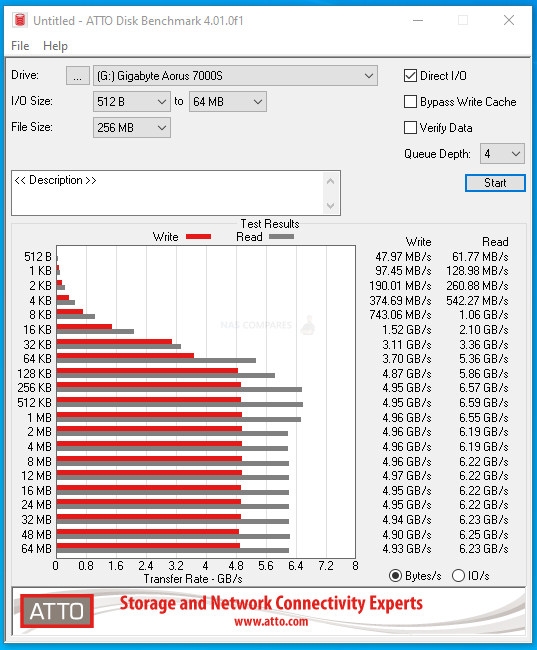 |
 |
The larger test file, unsurprisingly, produced higher results of sequential Read/Write at 6,590MB/s and 4,980MB/s respectively – that write is still a pinch less than I would like to see, even at 1TB over PCIe with the Phison E18. The IOPS still maintained a similar level as before.
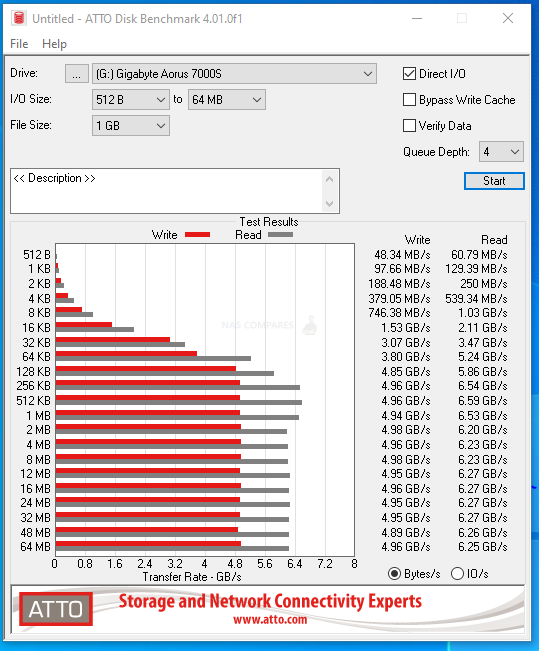 |
 Finally, I completed the ATTO Benchmark tests with a 4GB Test file and the performance remained consistent: Finally, I completed the ATTO Benchmark tests with a 4GB Test file and the performance remained consistent: |
Finally, to conclude the ATTO testing, I switched to a bigger 4GB file and re-ran the program. This ended up maxing out at a read/write of 6,590MB/s and 6,585MB/s respectively – which although still not cracking the reported 7,000MB/s is still mighty impressive.
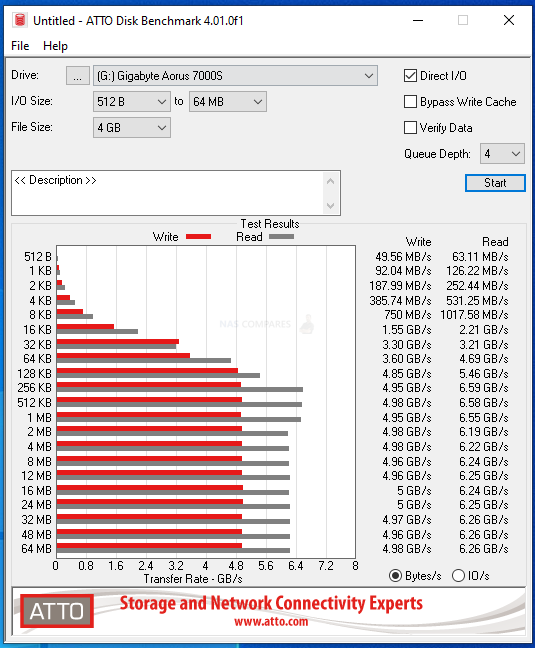 |
 |
Next, although the ATTO tests were quite good, but not what I would have hoped from this SSD, so I moved on to the Crystal Disk Mark testing to see how well it would handle our lasts barrage of tests. The first test was the 1GB file testing, which measured both sequential and random, as well as the read and write IOPS. 1GB file test files provided:
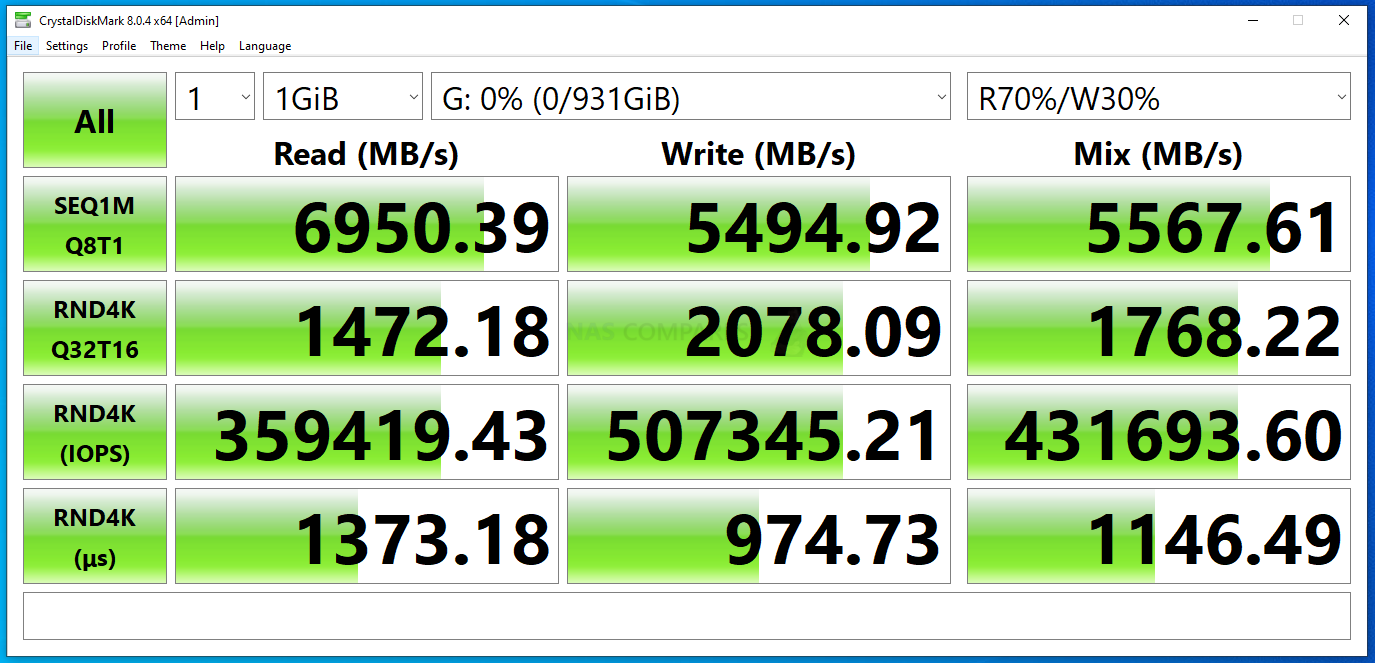
Although this never crossed into the 7,000MBs mark (I suspect down to my test hardware), both in the 1GB test and when I tested the 4GB test file routine, we saw increased benchmark scores 6,975MB/s Read and 5,508MB/s Write, as well as increased IOPS reported. Given the 1TB Gigabyte Aorus 7000s model is rated at 7,000/5,500MB/s, this is remarkably close to hitting the maximum reported benchmark!
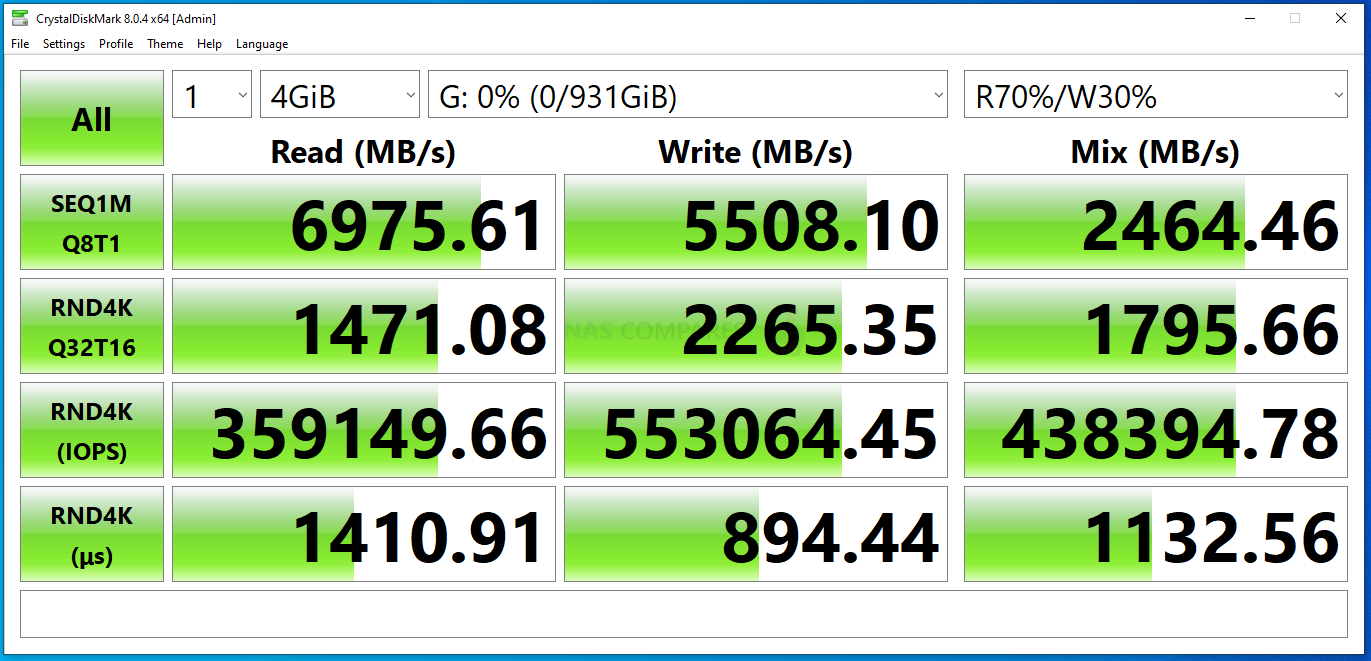
Finally, I went for the biggest test file at 16GB on AS SSD and this still gave some solid results and although the IOPs were a pinch lower, this might have hit closer to that reported 700/350K with use of a Xeon test machine:

Next, I switched to AS SSD for benchmarks. First up was 1GB file testing, both on sequential and 4K random:
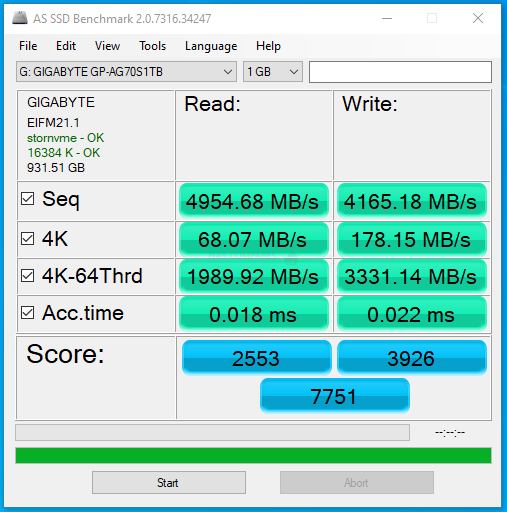 |
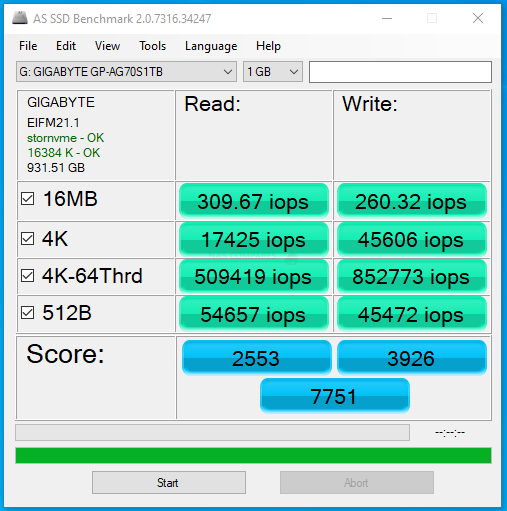 |
The results were a pinch lower than I would have liked to see, so I then moved onto the 3G test file. These were noticeably better, both in transfers and 4K random:
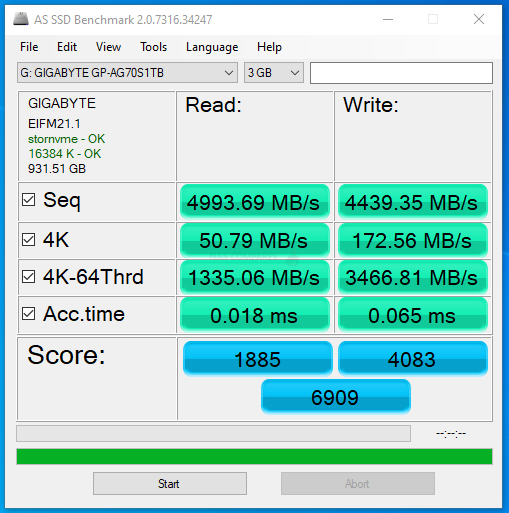 |
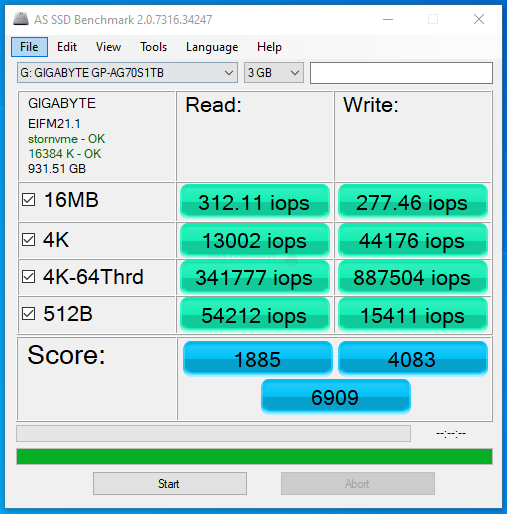 |
I decided to chase this a little further and upped the ASS SSD Test file to 5GB and was pleased with the results. Still ‘on paper’ not as high as the Crystal Diskmark tests.
 |
 |
Ordinarily, I would introduce tests like BlackMagic and AJA into the mix here, but even a short burst of testing on an NVMe like this would over saturate the cache memory on board. Nevertheless, in the short term we still could ascertain the reported performance on 1GB, 4GB and 16GB file testing was:
256MB AJA File Test Results (Max) = 5,907MB/s Read & 5,400MB/s Write

1GB AJA File Test Results (Max) = 5,881MB/s Read & 5,427MB/s Write

4GB AJA File Test Results (Max) = 5,974MB/s Read & 5,372MB/s Write

16GB AJA File Test Results (Max) = 5,974MB/s Read & 5,427MB/s Write

Overall, the Gigabyte Aorus 7000s was certainly able to provide some solid performance, as well as potentially exceed the test figures here on a more powerful machine. Given the reported Read and Write statistics that the brand has stated publically, I think there is enough evidence here to back up those claims.
Gigabyte Aorus 7000s SSD Review – Conclusion
It is very hard to find any real fault in the Gigabyte Aorus. I know that sounds spectacularly restrained praise, but that is only because the Aorus 7000s finds itself in a rather more densely populated tier of the industry than it should have been! The architecture, performance, endurance and build are definitely impressive and give me a tremendous sense of confidence in the product, but because it is so similar to other SSDs like the MSI SPATIUM M480 and Sabrent Rocket 4 Plus, it blends in with them, rather than standing out on its own merit. I DO like the Aorus 7000s, genuinely love the inclusive heatsink (not just the fact it is included, but the quality of the thing!) and would DEFINITELY recommend it. I just wish it could stand out from the crowd a little more!
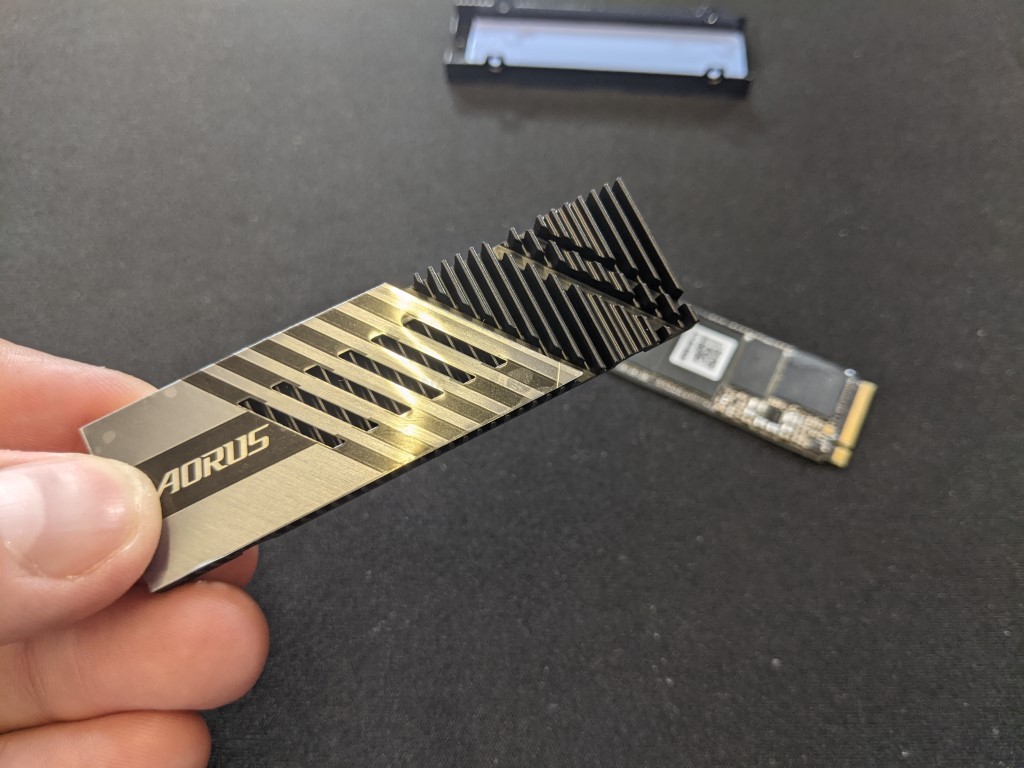
You cannot fault the Aorus 7000s NVMe SSD for its performance in 2021/2022, as it does not over-promise on what it can do. We ran all our usual tests and it hit the highs and lows of Throughput and comparative IOPS to others, just as the brand volunteered. The Gigabyte Aorus is a mature and grown-up SSD and not one that is trying to challenge bigger drives like the Seagate Firecuda 530. Had it been released a few months earlier, it would have made a significantly bigger splash on the professional gaming and video editing market, but now runs the sight risk of getting lost in the paddock of Phison E18 SSDs that are arriving on the market around this. The Aorus’ price point and availability certainly make it appealing, but the shaky SSD market making a slow recovery from Pandemic changes, Chia stock issues and semiconductor shortages means this SSD might not be as desirable as it should be when it is not as abundant at the manufacturing level as the likes of Seagate, Samsung and WD’s offerings being so copious. This IS a good SSD and although the IOPs are a touch lower than I would like, its durability, performance at both 1TB and 2TB and inclusive slimline prosumer heatsink make it a very good drive indeed!
| PROs of the Gigabyte Aorus 7000s | CONs of the Gigabyte Aorus 7000s |
| Genuinely Impressive Performance
Made by a Gamer Mobo Preferred Manf PS5 Compatibility Confirmed Heatsink Included and PS5 Compatible 96 Layer 3D TLC NAND Hugely Beneficial Phison E18 SSDs Always Delivery! Surpasses Samsung/WD PCIe 4 SSDs in some key areas |
IOPS rating is noticeably lower than most competitors
Endurance (DWPD/TBW) is unimpressive Still Outperformed by the Firecuda 530 |
🔒 Join Inner Circle
Get an alert every time something gets added to this specific article!
This description contains links to Amazon. These links will take you to some of the products mentioned in today's content. As an Amazon Associate, I earn from qualifying purchases. Visit the NASCompares Deal Finder to find the best place to buy this device in your region, based on Service, Support and Reputation - Just Search for your NAS Drive in the Box Below
Need Advice on Data Storage from an Expert?
Finally, for free advice about your setup, just leave a message in the comments below here at NASCompares.com and we will get back to you. Need Help?
Where possible (and where appropriate) please provide as much information about your requirements, as then I can arrange the best answer and solution to your needs. Do not worry about your e-mail address being required, it will NOT be used in a mailing list and will NOT be used in any way other than to respond to your enquiry.
Need Help?
Where possible (and where appropriate) please provide as much information about your requirements, as then I can arrange the best answer and solution to your needs. Do not worry about your e-mail address being required, it will NOT be used in a mailing list and will NOT be used in any way other than to respond to your enquiry.

|
 |
How Much RAM Do You Need in Your NAS?
A Buyer's Guide to Travel Routers - GET IT RIGHT, FIRST TIME
Jonsbo N6 DIY NAS Case Review
The Best Bits (and Worst Bits) of NAS of 2025!
Minisforum MS-02 Ultra Review
Minisforum N5 NAS, 6 Months Later - Better, Worse, the Same?
Access content via Patreon or KO-FI





Discover more from NAS Compares
Subscribe to get the latest posts sent to your email.


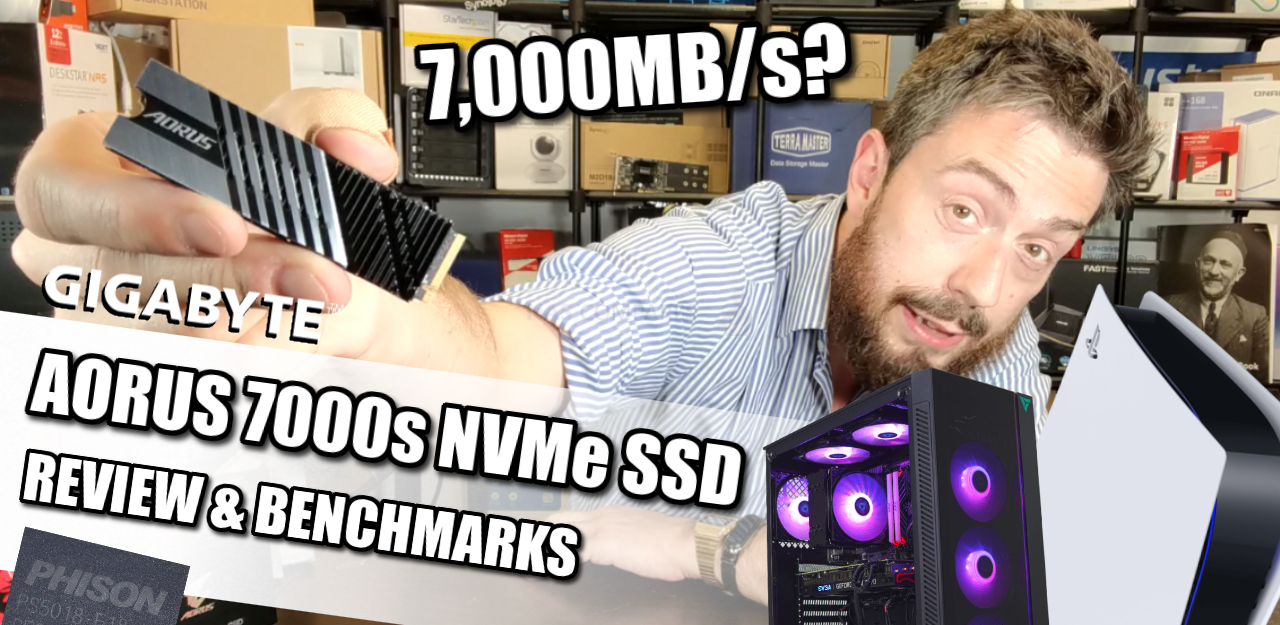
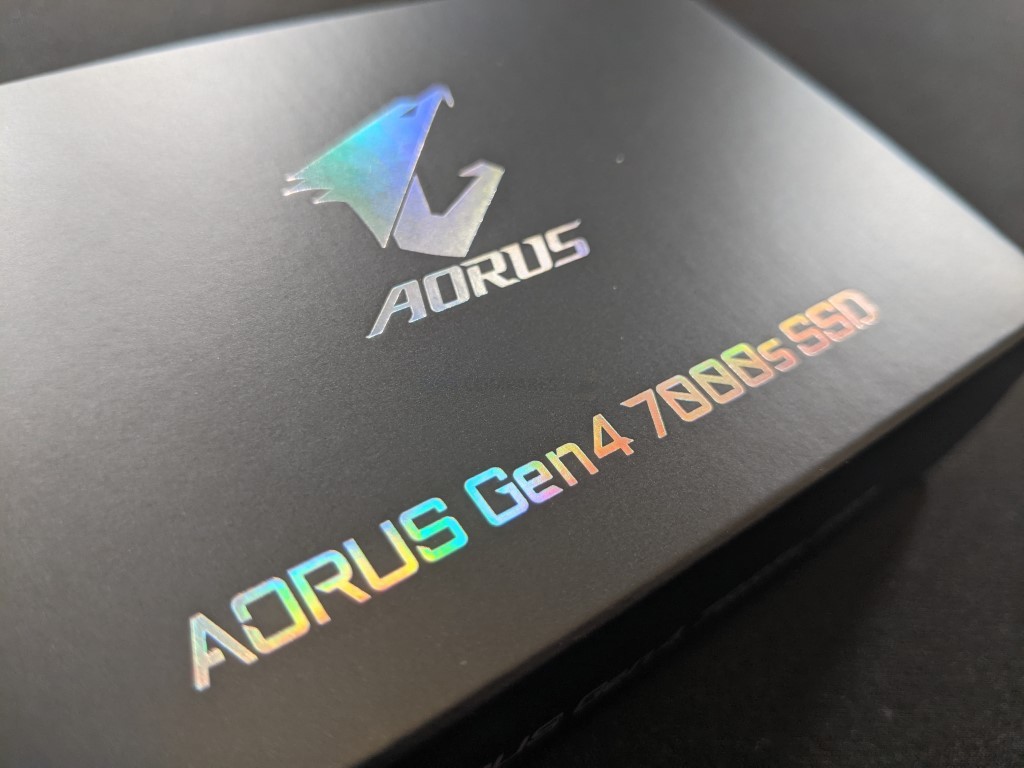






A really good & detailed video ????
REPLY ON YOUTUBE